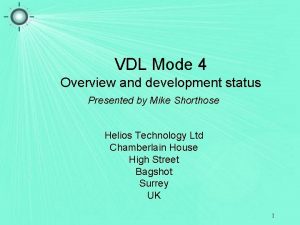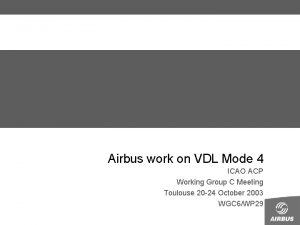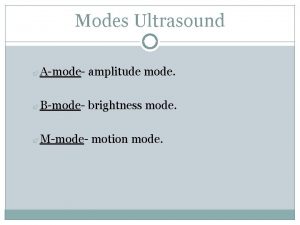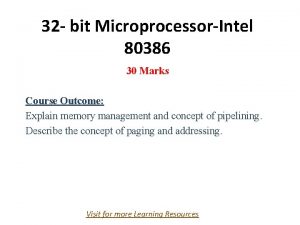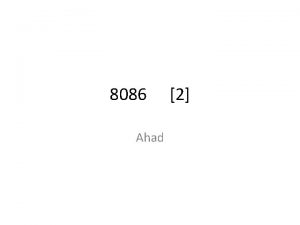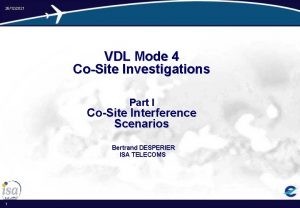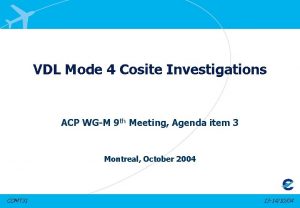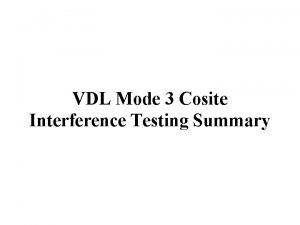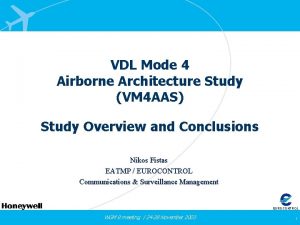28022021 VDL Mode 4 CoSite Investigations Part I








- Slides: 8

28/02/2021 VDL Mode 4 Co-Site Investigations Part I Co-Site Interference Scenarios Bertrand DESPERIER ISA TELECOMS 1

28/02/2021 Problem Overview and Study Objectives Characterize air co-site scenarios considered to be representative of real and anticipated operational cases u è è è VDL Mode 4 & AM VDL Mode 4 & VDL Mode 2 Both point to point and broadcast VDL Mode 4 usage are addressed Prepare the elaboration of detailed testing plan according to the identified scenarios u Explore operational quality of service requirements to identify related interference criteria u 2

28/02/2021 How to build a Scenario ? u Victim system User Profile: in time & size distribution (G/A or A/A) è Received victim power è u Interferer system User : in time & size distribution (A/G or A/A) è Interferer power at the victim receiver input è Frequency separation from victim channel è 3

28/02/2021 How to build a scenario ? Operational Scenario Testing Scenario Airborne type : • Antenna coupling • Feeder Loss (Tx, Rx) • Co-site Interferer system power Interferer Power @ victim receiver input Applications classes in use: • Broadcast • Point to point Technologies properties: • Network overheads • Access Mode… Typical flight: • Flight phase • On event application triggering Spectrum: • ICAO FMG Frequency planning 4 Interferer Channel occupancy profile Victim Power @ victim receiver input Victim Channel occupancy profile Frequency Separation

28/02/2021 Interferer Power Large Interferer Isolation (d. B) Opp. Same Opp. 35 50 19 45 17 37 3 -38 Tx Power (d. Bm) Voice Interferer power at receiver input (d. Bm) 5 Interferer power at receiver input (d. Bm) 3 -53 -21 46 8 Tx Power (d. Bm) VDL 4 Light Same Rx Feeder loss (d. B) Total Losses (d. B) Small -49 -20 42 -7 21 43 5 3 40 -7 20 40 -10 18 -40 0 37 14 17 -3

28/02/2021 Usage Profiles u AM profile are based on real data (Erctl voice profile study) u 4 categories of Data Link profiles have been defined è Ground to Air Surveillance broadcast (TIS-B) è Air Surveillance broadcast (ADS-B) è Sporadic point to point (CPDLC, CM, FIS, D-SIGMET, NOTAM, FLIPCY, DYNAV …) è Periodic point to point (ADS-C, CAP…) 6

28/02/2021 Minimum victim signal level DSB-AM From ground Min signal at air receiver antenna Annex 10, Vol. III 7 75 V/m -82 d. Bm DSB-AM From air 75 V/m -82 d. Bm VDL 4 From ground VDL 4 From air VDL 2 From ground 75 V/m -82 d. Bm 35 V/m -88 d. Bm 75 V/m -82 d. Bm Feeder loss 3 d. B Antenna gain 0 d. B Minimum victim signal at receiver input -85 d. Bm -91 d. Bm -85 d. Bm

28/02/2021 Spectrum u Current Required guard band DSB-AM VDL 4 (Assumed based on current VDL 2 To be revisited ) VDL 4 VDL 2 4 Channels 1 Channel 100 k. Hz 25 k. Hz VDL 2 8
